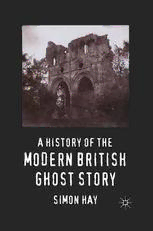
A History of the Modern British Ghost Story PDF
Preview A History of the Modern British Ghost Story
A History of the Modern British Ghost Story This page intentionally left blank A History of the Modern British Ghost Story Simon Hay AssociateProfessor,DepartmentofLiteraturesinEnglish,ConnecticutCollege Palgrave macmillan ©SimonHay2011 Softcoverreprintofthehardcover1stedition2011978-0-230-27832-5 Allrightsreserved.Noreproduction,copyortransmissionofthis publicationmaybemadewithoutwrittenpermission. Noportionofthispublicationmaybereproduced,copiedortransmitted savewithwrittenpermissionorinaccordancewiththeprovisionsofthe Copyright,DesignsandPatentsAct1988,orunderthetermsofanylicence permittinglimitedcopyingissuedbytheCopyrightLicensingAgency, SaffronHouse,6-10KirbyStreet,LondonEC1N8TS. Anypersonwhodoesanyunauthorizedactinrelationtothispublication maybeliabletocriminalprosecutionandcivilclaimsfordamages. Theauthorhasassertedhisrighttobeidentified astheauthorofthisworkinaccordancewiththeCopyright, DesignsandPatentsAct1988. Firstpublished2011by PALGRAVEMACMILLAN PalgraveMacmillanintheUKisanimprintofMacmillanPublishersLimited, registeredinEngland,companynumber785998,ofHoundmills,Basingstoke, HampshireRG216XS. PalgraveMacmillanintheUSisadivisionofStMartin’sPressLLC, 175FifthAvenue,NewYork,NY10010. PalgraveMacmillanistheglobalacademicimprintoftheabovecompanies andhascompaniesandrepresentativesthroughouttheworld. Palgrave®andMacmillan®areregisteredtrademarksintheUnitedStates, theUnitedKingdom,Europeandothercountries. ISBN978-1-349-32615-0 ISBN978-0-230-31683-6(eBook) DOI10.1057/9780230316836 Thisbookisprintedonpapersuitableforrecyclingandmadefromfully managedandsustainedforestsources.Logging,pulpingandmanufacturing processesareexpectedtoconformtotheenvironmentalregulationsofthe countryoforigin. AcataloguerecordforthisbookisavailablefromtheBritishLibrary. AcatalogrecordforthisbookisavailablefromtheLibraryofCongress. 10 9 8 7 6 5 4 3 2 1 20 19 18 17 16 15 14 13 12 11 Contents Acknowledgments vi Introduction:EventheDeadWillNotBeSafe 1 1 AFailedModernity:TheGhostStoryastheBadConscience oftheHistoricalNovel 28 2 FragmentandTotality:TheGhostStoryandEarlyVictorian Realism 57 3 SupernaturalNaturalism:TheGoldenAgeofthe GhostStory 91 4 GhostsThataWhiteManCanSee:TheGhostStory andEmpire 124 5 ‘IhadnotThoughtDeathhadUndonesoMany’: ModernismandtheGhost 157 6 TheGhostStoryandMagicRealism 190 Conclusion:GhostsandHistory 227 Notes 233 WorksCited 238 Index 249 v Acknowledgments Like many academic works, this book is far more a collective project thanitstitlepagesuggests.Iwouldliketothankthemanyaudiencesin Australia,Canada,England,Ireland,NewZealandandtheUnitedStates who responded to and helped shape earlier versions of parts of these arguments; the Spring 2009 students of 494Z: The Ghost Story, who likewise smoothed the rough corners of some of this work; the many academicsIworkedwithasastudent,butmostespeciallyWarwickSlinn and Ian Baucom; Zach Smith, for compiling this book’s index; Steve Levin,whoreadmostofthisbookandwhosecommentaryimprovedit noend;ChristianThorne,withoutwhoseconversations,prompts,and editing,thisbookwouldbarelyexist;andmostofallCybeleLocke,who managedtobebothsolidlysupportiveandrefreshinglyinsightfulinher responsestomywork.Thankyouall. vi Introduction: Even the Dead Will Not Be Safe This book is mostly about the form of modern ghost stories, rather thantheircontent.Butthesecanonlybeseparatedinanabstractsense, andworkingoutthestories’form,atdifferenthistoricalmoments,will requirepayingattentiontotheircontentaswell.Atthelevelofcontent, ghost stories repetitively address a set of socio-historical concerns that weneedtotakeintoaccountbeforewecanreallyextrapolatefromthem anything significant about form. Thus, I am going to take a few pages now to explore and explain those socio-historical concerns, and some of the ways the modern English ghost story addresses them. I will also explainsomethingofwhateachoftheseterms–‘modern,’and‘English,’ and‘ghoststory,’aswellas‘history’–mean,inthecontextofthisbook. IbeginwithareadingofCharlotteRiddell’s‘TheOpenDoor,’aghost storyfromthelatenineteenthcenturythatisinmanywaysrepresenta- tive of the genre as a whole. It turns on ideas of trauma, history, class, andEmpire,allofwhicharecommonstockforghoststories;thisread- ingprovidesaframeworkforthefocusongenrethatinformsthebook asawhole.Alongtheway,Iwilljumpsidewaysafewtimesintoquick readingsofotherghoststories,forcomparisonsandconfirmations.And Iwillconcludewithasummaryofthechaptersofthebook,explaining howitsfocusmovesfromthenineteenth-centuryghoststory,initsvar- ious forms, to the literary ghost’s migration, in the twentieth century, fromthatgenre–itsbirthplaceandnativehome–intomodernistand postcolonialnovels. Talking about form and about genre raises the always-tricky ques- tion of the relation between any single story and the genre as a whole. In what sense is any particular story representative or exem- plary of the genre? ‘The Open Door’ is an exemplary ghost story, but ‘exemplary’heremeanstwopreciselycontradictorythings,andImean 1 2 AHistoryoftheModernBritishGhostStory both:something is ‘exemplary’ if it rises above the others of its type, if it can be marked out as unique; but something is also ‘exemplary’ if it is a mere example of its type, if it is average and ordinary. Some- thing of this dilemma is at the heart of all representation, I think, but especiallyrepresentationthathastodowithtrauma,sincetraumasare themselvesalwaysbothuniqueandrepetitive;andthedilemmaisalsoa keytothegenreoftheghoststory,astotheideaofgenremorebroadly. Anyindividualghoststorygivesanaccountofaspecificandirreducible trauma;somespecifichauntedmansion,murderedcount,orinterrupted inheritance.Butghoststoriescollectively,ghoststoriesasagenre,deny precisely the irreducibility of those traumas. To read an anthology of ghost stories is to watch the several traumas of each story accumulate, like the history that Benjamin’s angel watches piling up, to the point where history figures only as a single repeated trauma, the traumatic transition, as I will argue in this introduction, from feudalism to cap- italism lived out over and over again. Exemplarity, then, is not just a problem we face when trying to understand a genre through its exam- ples,butratheristhestructurallogicoftheghoststoryasagenre.Every ghost story is indeed both the same and unique, and the conclusions I want to draw from Riddell’s story are both specific to that story and representativeofthegenreasawhole,andthesustainedcontradictions betweenthoseclaimsarethemselveskeytoworkthatghoststoriesdo. Ofdoors,theiropeningandclosing In Charlotte Riddell’s ‘The Open Door’ (1882), the door of the story’s title stands in Ladlow Hall, and this door is at the center of the story’s haunting:bolt,wedge,orfixhowtheymay,noneofthecharacterscan keepitclosed;assoonastheyturnaway,andturnback,thedoorstands open again. Ladlow Hall is the property of Lord Ladlow, as we might expect,thoughitiscurrentlybeingleasedtoaMrCarrison.Thestory’s haunted space, that is, as so often in ghost stories, is an aristocratic propertyintowhichcommonersaremoving. The story begins, though, not in this genteel countryside, but in anotherlocationalsocrucialtothegenreoftheghoststoryasawhole, a space that the story wants us to imagine as the urban and bourgeois opposite of rural aristocratic property: ‘the office of Messrs Frimpton, FramptonandFryer,auctioneersandestateagents,’inLondon(p.256). The Dickensian name is clue enough to the mockery here directed at the firm; its pettiness and insignificance, its, if you like, deficiency of theblood,isquicklyspeltout.Ournarratorandhero,thoughaclerkin Introduction 3 this firm of solicitors, quickly claims his distance from and superiority toit,utteringadistasteweareinvitedandexpectedtoshare:‘Ididnot liketheoccupationofclerkinanauctioneer’soffice,andIdidnotlike myemployers,’hetellsus,inaparentheticalaside,withinapageofthe opening(p.257).Healsodemonstratesasuperiorabilitytoknow,read, and judge the careful gradations of social hierarchy. Mr Carrison, the current lessee of Ladlow Hall, is identified by one of the firm’s senior clerksasa‘tea-dealer,’butourhero,Phil,recognizestheinadequacyof thisdescription,identifyingCarrisonas‘amerchantintheChinatrade, possessed of fleets of vessels and towns of warehouses’ (p. 257). Phil’s socialsuperiorityisthusmarked,initiallyatleast,notbybirthbutbyhis ability to recognize and interpret Carrison’s social rank with precision. Wedo,however,quicklylearnthatPhil’sfamily,thoughpoor,wasonce ‘betteroff,’Phil’sfatherhaving‘ownedasmallpropertyinthecountry’ (p.258).Phil’ssenseofthedetailsisappropriatelyvague–gentlemendo notbotherthemselveswiththedetailsofmoney,afterall–buthedoes explain that the property was lost ‘owing to the failure of some bank.’ ‘Wemighthavemanagedonourincome,Ithink,ifwehadnotbeenso painfullygenteel,’hethenremarks(p.258). Throughouttheeighteenthandnineteenthcenturies,thelargestpor- tionoftheincomeofmostsolicitorslikeFrimpton,FramptonandFryer camefromtheirworkaroundtheownership,rent,legitimacyandinher- itanceofthepropertyofthearistocracyandgentry(Offer1981).Butin Riddell’sghoststory,theworkthatPhildoesonbehalfofCarrisonand LordLadlowisnotthestandardworkofsolicitorsandclerks,notdraw- ingupdocumentsofownership,transferenceorconveyance,leaseholds andrents,entailmentorinheritance.Ratherthananyofthat,Philrids the manor house of its ghost. And so we run into the first big point abouttheghoststorythatwearegoingtowanttocarrywithus:ghost storiesareoftenamatterofthelaw,aslongasweunderstandthelawas theprofessionthathelpsonetodealwiththepast,withitsburden:the consequences of past actions. A good lawyer is one who can make the pastgoawayandsoisindistinguishablefromanexorcist. Thelaw-clerkasexorcist:Itisnotsostrangealeap.Itturnsoutmany nineteenth-century ghost stories feature lawyers or solicitors like Phil. We eventually learn that Phil’s full name is Theophilus Edlyd, though we also learn that the other clerks call him ‘Sandy’ after ‘an ill-looking Scotchman...theyhadseenatthetheatre’(p.256).Thismany-named- nessfunctionsasamarkerofPhil’sunfixedanduncertainsocialstatus; onewayofdescribingthearcofthenarrative,then,isitsprocessof‘fix- ing’ Phil’s social position to a single name and a single role; no longer
